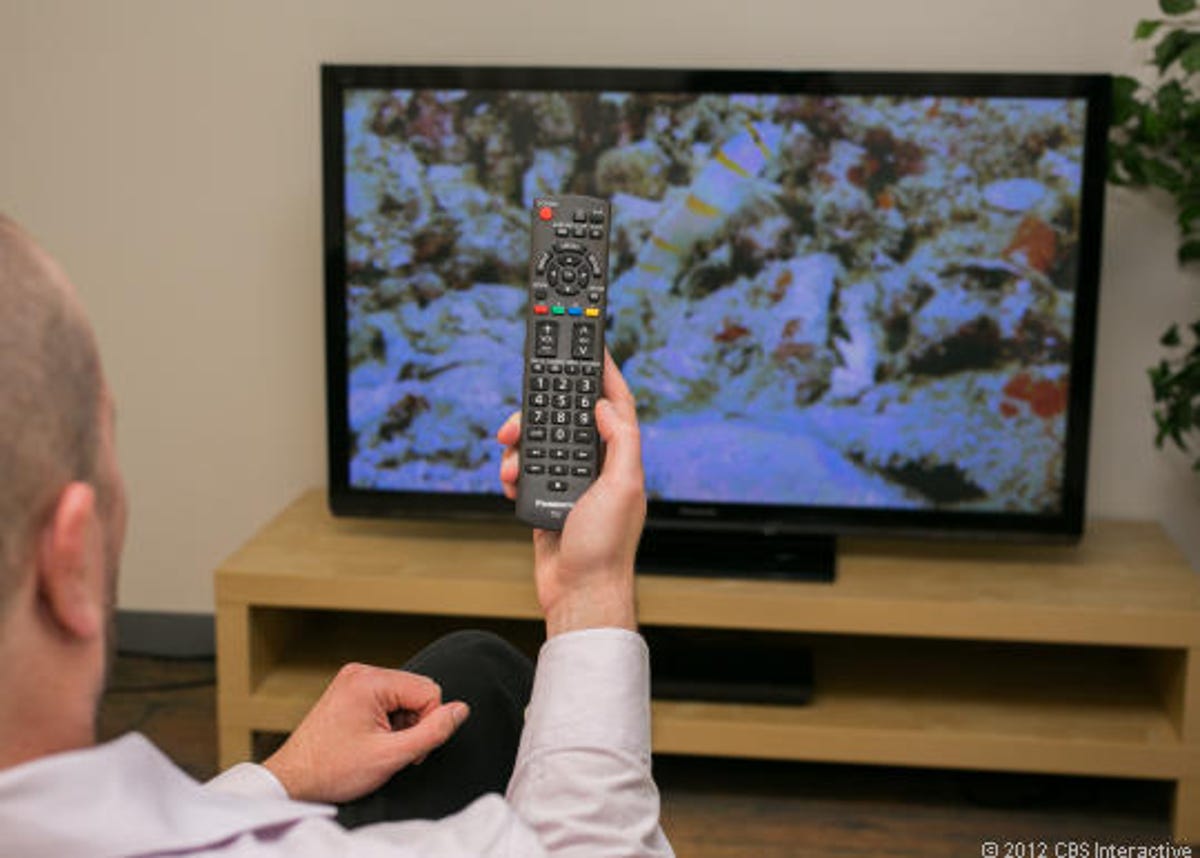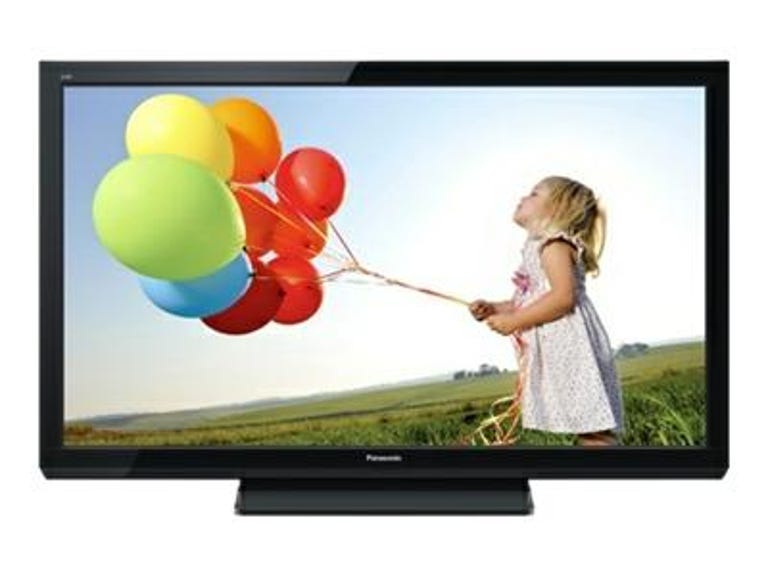 Why You Can Trust CNET
Why You Can Trust CNET Panasonic TC-PX5 review: Panasonic TC-PX5
The entry-level Panasonic TC0PX5 series displays good shadow detail and has better black levels than some LCDs at the same price or higher, but the green cast it puts over everything may have you seeing red.
In CNET's lists of the best 2012 televisions, no lineup dominates like Panasonic's plasmas. No matter whether you pay $700 for a U50 or $3,700 for a VT50, our tests and observations have demonstrated that models across the entire range are the televisions to buy at their respective prices. But cracks had to appear somewhere, and in the Panasonic X5, they have. This is the only Panasonic plasma I don't recommend. In fact, much like many of the company's LCD and LED TVs, I encourage you to actively avoid it.
The Good
The Bad
The Bottom Line
The X5 smacks of an effort to simply fill in a price point, and quality has ultimately suffered. While there are no features to speak of -- this is to be expected at the entry level -- it's the picture quality that lets it down. Black levels are fairly average, but shadow detail would be good if shadows weren't so green. There is a green cast to everything that makes skin tones in particular look very sickly. This TV is unfortunately the opposite of accurate -- if you only watch rain forest documentaries, it might be fine, but for everyone else this is a pretty disappointing TV compared with other cheap alternatives like the Samsung PNE450.
Series information: I performed a hands-on evaluation of the 50-inch Panasonic TC-P50X5, but this review also applies to the 42-inch screen size. The two sizes have identical specs and according to the manufacturer should provide very similar picture quality.
| Models in series (details) | ||||
| Panasonic TC-P42X5 | 42 inches | |||
| Panasonic TC-P50X5 (reviewed) | 50 inches | |||
Design
The Panasonic X5 follows the family line pretty closely in terms of design. The only difference between it and the U50 is the lack of a silver strip along the bottom. Otherwise what you get is a TV with a glossy black bezel and a rectangular, nonswiveling stand. If you're wall-mounting the TV, you may notice it is noticeably thicker than its competition -- 3 inches versus 2.5 for the LG PA4500, for example.

The remote control that ships with the unit is a good size and reasonably ergonomic with enlarged volume and channel buttons.
The menu system may look like the typical Panasonic offering but with one major flaw -- the first option in the Picture submenu is "Reset to defaults," and it's incredibly easy to accidentally click. I did so seven or more so times during calibration, resetting all my changes to zero, and found it infuriating.
| Key TV features | ||||
| Display technology | Plasma | LED backlight | N/A | |
| Screen finish | Glossy | Remote | Standard | |
| Smart TV | No | Internet connection | No | |
| 3D technology | N/A | 3D glasses included | No | |
| Refresh rate(s) | 60Hz | Dejudder (smooth) processing | No | |
| DLNA-compliant | No | USB | Photo/Music/Video | |
| Other: SD card slot | ||||
Features
The X5 is Panasonic's cheapest TV and doesn't have any of what I'd consider "modern" features like smart TV or even 3D. This is a 720p set, as most of the entry-level plasmas are, and so features a resolution of 1,024x768 pixels. The TV also has a 600Hz subfield drive, and while most plasmas have it these days, I bring it up in the absence of any other significant features.
However, Panasonic is one of the few companies to include an SD card slot on its TVs, and does so here, to make it easy to look at photos and videos from cameras.
Picture settings: Want to make a dirt-cheap plasma TV? You gotta make cuts somewhere, and in the case of Panasonic, it's in the number of advanced picture controls. Though you get a lot of presets -- including a Game mode -- there is no way for calibrators such as ourselves to correct any grievous problems with color or grayscale. In the case of this TV, that's an issue given its poor initial color; in addition, Samsung and LG do offer advanced color controls on their low-end plasmas.
Connectivity: The TV includes a bare minimum of inputs: two HDMI ports, a shared component/composite port, and a USB input.
Picture quality
After hogging the headlines of our plasma TV reviews all year, the company's luck had to end somehere, and that's here. When summing up a TV's picture quality the two most important elements are black levels and color. When a TV isn't able to compete on those two things, it doesn't really matter how good its picture processor is, or how many features it has. The Panasonic, unfortunately, is mediocre. After good performance from the U50 I was curious to see how deep the rabbit hole went, and it seems in this case not that far -- it's more of a pothole here in Panasonic's "X" series.
While competing companies have been able to engineer good value-for-money televisions at a sub-$500 price, this is seemingly beyond Panasonic's capabilities. The X5 is a cheap TV and it performs like one, but that's no longer good enough. Black levels were passable and shadow detail was good, but the TV's main problem can be summed up in one word: green. Green skin tones and green shadows. No, it doesn't look like the old CRT screens when they died (all green, all the time!), this is a more insidious green cast to objects. No matter its other attributes, this issue alone was enough to spoil the X5's picture.
Click the image at the right to see the picture settings used in the review and to read more about how this TV’s picture controls worked during calibration.
| Comparison models (details) | ||||
| Samsung PN51E550 | 51-inch plasma | |||
| Panasonic TC-P50U50 | 50-inch plasma | |||
| Sony KDL-46EX640 | 46-inch, LCD | |||
| LG 50PA6500 | 50-inch plasma | |||
| LG 42PA4500 | 42-inch plasma | |||
| Samsung PN51E450 | 51-inch plasma | |||
Black level: If there's one strength here, it's that shadow detail is very good. At the start of "Batman Begins," the cell walls were easy to decipher, and the only TV to better pluck details out of darkness was the U50.
The X5's black levels are about as deep as those of the LG PA6500, which is to say mediocre for a plasma TV, and both fell way short of the Samsung E450's black levels. In its favor, though, the Panasonic didn't have the same problem with image retention that the LG did, with little ghosting remaining of contrasting images.
Unusually, I found big differences between the Custom and Movie modes on this TV, especially in regard to black levels. I originally calibrated the TV in Custom mode but found it had some solarization issues (choppy rather than smooth gradations between colors and brightness intensities), which led to unnatural skin tones and crushed blacks. The Movie mode was better, but the "green shadows" problem was still there.
Color accuracy: The Panasonic continues its green stampede when it comes to color accuracy, and this especially extends to skin tones. Whether it was an incredibly sickly looking Harry Potter or a bilious Captain Kirk, the pale green effect it had on faces caused my fellow reviewer David Katzmaier to label this television a "Kermitron (TM)." We're used to blue shadows on LCD screens, but green looks terrible.
Looking at the RGB color chart (of which I've added a screenshot below and which is available in full at the bottom of the page) you can begin to see where the green problem comes from. See how that little green dot is way out in.. well... Green-land? That's bad, and unfortunately it's impossible to correct with the minimal controls this television offers. The TV's grayscale is another major contributor; while OK in the brighter areas, it's noticeably green in middle and darker areas.
This green mist sapped images of energy and particularly the reds of the Starfleet Academy cadets' uniforms, and while it boosted the naturalistic scenes of "The Tree of Life," Panasonic can't expect its users to just watch nature documentaries ad nauseam.
Video processing: The one highlight I alluded to earlier was that the picture processing was very good, but unfortunately this doesn't absolve the TV of its other sins. The TV was able to both pass the 1080i test and correctly translate a 24p signal which means it at least mates well with a Blu-ray player.
The TV had one trick left up its sleeve in that there was no solarizing (at least in Cinema mode) of colors as found on the other sets, even the otherwise godly U50. The sunrise during "The Tree of Life" looked the best on the X5 with no fake rings around the sun, just a smooth gradation of colors.
Like any 720p plasma at 50 inches, it can be possible to see pixel structure depending on your seating distance. At a distance of 8 feet it was easiest to discern the vertical structure on the X5 over any of the other 720p TVs in the lineup, which included a 50-inch Samsung and a 42-inch LG.
Bright lighting: While the Panasonic's blacks don't look as green in the light, they do look washed out compared with the twin LG televisions in our lineup. The X5, on the other hand, shows less contrast in the light, as is typical of budget plasmas and older models alike. Blacks typically turn to brown and perhaps it is this that counteracts the greenness.
Power consumption: While the Panasonic X5 is a 720p plasma, it didn't perform as well as the other similarly specified televisions in our power testing. I expect 720p plasmas to be more efficient than 1080p models because they have a third of the cells (2.1 million pixels versus around 780,000 for a 1,024x768 resolution). Instead the X5 used about the same amount of power as the 1080p PA6500 with 164W when calibrated.
| Panasonic TC-P50X5 | Picture settings | ||
| Default | Calibrated | Power save | |
| Picture on (watts) | 81.102 | 164.08 | n/a |
| Picture on (watts/sq. inch) | 0.08 | 0.15 | n/a |
| Standby (watts) | 0.25 | 0.25 | n/a |
| Cost per year | $17.98 | $36.17 | n/a |
| Score (considering size) | Average | ||
| Score (overall) | Average | ||
| GEEK BOX: Test | Result | Score |
|---|---|---|
| Black luminance (0%) | 0.0171 | Average |
| Avg. gamma | 1.9931 | Poor |
| Near-black x/y (5%) | 0.302/0.3385 | Average |
| Dark gray x/y (20%) | 0.3082/0.3342 | Poor |
| Bright gray x/y (70%) | 0.3089/0.3319 | Average |
| Before avg. color temp. | 6754.3846 | Poor |
| After avg. color temp. | 6709.4937 | Poor |
| Red lum. error (de94_L) | 3.4285 | Poor |
| Green lum. error (de94_L) | 9.1758 | Poor |
| Blue lum. error (de94_L) | 1.0272 | Good |
| Cyan hue x/y | 0.1887/0.2967 | Poor |
| Magenta hue x/y | 0.3308/0.1581 | Average |
| Yellow hue x/y | 0.4315/0.5269 | Poor |
| 1080p/24 Cadence (IAL) | Pass | Good |
| 1080i Deinterlacing (film) | Pass | Good |
| Motion resolution (max) | 650 | Average |
| Motion resolution (dejudder off) | 650 | Average |



